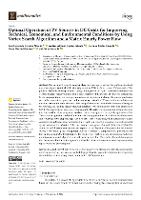Abstract
This document presents a master–slave methodology for solving the problem of optimal operation of photovoltaic (PV) distributed generators (DGs) in direct current (DC) networks. This problem was modeled using a nonlinear programming model (NLP) that considers the minimizationof three different objective functions in a daily operation of the system. The first one corresponds to the minimization of the total operational cost of the system, including the energy purchasing cost to the conventional generators and maintenance costs of the PV sources; the second objective function corresponds to the reduction of the energy losses associated with the transport of energy in the network, and the third objective function is related to the minimization of the total emissions of CO2 by the conventional generators installed on the DC grid. The minimization of these objective functions is achieved by using a master–slave optimization approach through the application of the Vortex Search algorithm combined with a matrix hourly power flow. To evaluate the effectiveness and robustness of the proposed approach, two test scenarios were used, which correspond to a grid connected and a standalone network located in two different regions of Colombia. The grid-connected system emulates the behavior of the solar resource and power demand of the city of Medellín Antioquia, and the standalone network corresponds to an adaptation of the generation and demand curves for the municipality of Capurganá-Choco. A numerical comparison was performed with four optimization methodologies reported in the literature: particle swarm optimization, multiverse optimizer, crow search algorithm, and salp swarm algorithm. The results obtained demonstrate
that the proposed optimization approach achieved excellent solutions in terms of response quality, repeatability, and processing times.














